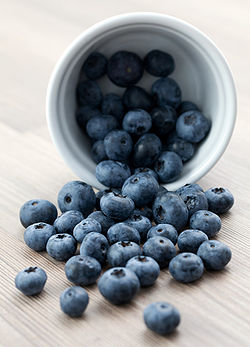Bilberry
From Wikiwel
Other Names: Airelle, Arándano, Bilberry Fruit, Bilberry Leaf, Black Whortles, Bleaberry, Brimbelle, Burren Myrtle, Dwarf Bilberry, Dyeberry, European Bilberry, Feuille de Myrtille, Fruit de Myrtille, Gueule Noire, Huckleberry, Hurtleberry, Mauret, Myrtille, Myrtille Européenne, Myrtilli Fructus, Raisin des Bois, Swedish Bilberry, Trackleberry, Vaccinium myrtillus, Whortleberry, Wineberry, Blauwe bosbes,Heidelbeere, Blaubeere
Bilberry fruit is a close relative to the American blueberry. It's a common ingredient in pies, cakes and jams. The active constituents are thought to be antioxidants called anthocyanins.
See also : Pterostilbene
Special Precautions of Bilberry
- The dried, ripe fruit of bilberry is LIKELY SAFE for most people when eaten in typical food amounts. Bilberry fruit products, such as powders or extracts, also seem to be safe for most people.
- Bilberry leaf is POSSIBLY UNSAFE for most people when taken in high doses or for a long time. If you have diabetes, keep in mind that bilberry leaf might lower blood sugar. Monitor your blood sugar closely.
- Pregnancy or breast-feeding: Not enough is known about the use of bilberry during pregnancy and breast-feeding. Stay on the safe side and avoid use.
- Surgery: Bilberry might affect blood glucose levels. This could interfere with blood sugar control during and after surgery. Stop taking bilberry at least two weeks before a scheduled surgery.
- Medications for diabetes (Antidiabetes drugs) interacts with BILBERRY
- Medications that slow blood clotting (Anticoagulant / Antiplatelet drugs) interacts with BILBERRY
The benefits of Bilberry are
- Vision : Bilberry is primarily used for eye conditions. During World War II, British Royal Air Force pilots reportedly found that eating bilberry jam just before a mission improved their night vision which prompted researchers to investigate bilberry's properties. Bilberry is also used for glaucoma, macular degeneration, diabetic retinopathy and cataracts.
- Historically, bilberry fruits were used to treat diarrhea and scurvy. Today, bilberry fruits are taken to treat diarrhea, menstrual cramps, and circulatory problems. Edible berries such as bilberry, blueberry, cranberry, elderberry, raspberry, and strawberry are good sources of natural anthocyanin antioxidants and other antioxidants.
- Diabetes : Bilberry leaves have long been used in traditional medicine to control blood sugar levels in individuals with diabetes, and we now know that all types of berries can help lower blood sugar levels after consuming meals high in sugar.
- Strengthen blood vessels : The anthocyanins in bilberry may strengthen the walls of blood vessels, reduce inflammation and stabilize tissues containing collagen, such as cartilage, tendons and ligaments. Grape seed contains similar substances, however, bilberry's anthocyanins are thought to have particular benefits for the eye.
- Because bilberry is thought to strengthen blood vessels, it's sometimes taken orally for varicose veins and hemorrhoids.
- Preventing Cancer : Bilberries are a good source of Cyanidin.
- Pterostilbene is a powerful, natural antioxidant that is found in small amounts in, among other things, blueberries, grapes and cranberries. The polyphenol is a phyto-alexin, a substance that is part of the defense system of plants and protects them against pathogens such as bacteria and fungi. In Indian Ayurvedic medicine, pterostilbene is known as a blood or cardiac tonic. Pterostilbene is structurally related to resveratrol (a phyto-alexin from grapes) and has similar health-promoting properties. Pterostilbene has a few advantages over resveratrol: bioavailability is higher (70-90% vs 20-30%), pterostilbene stays in the body longer (105 vs 14 minutes) and oral absorption, cellular uptake and metabolic stability is better than of resveratrol. Factors that play a role in this are better fat solubility and less rapid breakdown and excretion. Both resveratrol and pterostilbene improve mitochondrial function and activate the enzyme SIRT-1 (producing effects similar to calorie restriction).
Main Combinations
- Diarrhea : Bilberry + Activated Charcoal
- Eye fatigue : Goji Berry + Tagetes + Bilberry + Ginkgo Biloba
